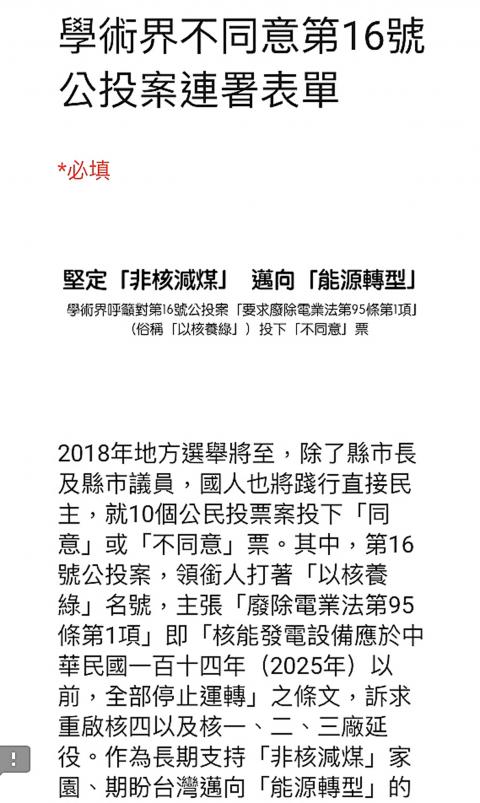Forty-eight academics yesterday launched a petition against a referendum that aims to scrap the government’s policy of achieving a “nuclear-free homeland by 2025,” collecting more than 200 signatures from colleagues on the first day.
Among the initiators were Academia Sinica academicians Lin Ming-chang (林明璋) and Lin Chang-shou (林長壽), National Chung Hsing University environmental engineering professor Tsuang Ben-jei (莊秉潔) and National Taiwan University geoscience professor Chen Wen-shan (陳文山).
The referendum, one of several to be held alongside the Nov. 24 elections, asks voters if they agree with abolishing Article 95-1 of the Electricity Act (電業法), which stipulates that all of Taiwan’s nuclear power generation facilities should be decommissioned by 2025.

Photo: Lin Hsiao-yun, Taipei Times
The petition’s organizers citied the risk of a nuclear plant disaster and environmental problems associated with the disposal of nuclear waste in urging people to vote against the referendum.
Regarding the referendum advocates’ call for resuming the construction of the Fourth Nuclear Power Plant in New Taipei City’s Gongliao District (貢寮), the petition organizers wrote that the proposal was not feasible, as the plant’s construction involved more than 500 infringements by Taiwan Power Co (台電) and cost nearly NT$300 billion (US$9.76 billion at the current exchange rate) before it was mothballed in 2015.
Nuclear plants in Taiwan face higher levels of risk and are costlier to operate than those in other nations, as Taiwan sits on active fault lines and is more likely to experience flooding and tsunamis, they wrote.
The referendum advocates proposed that 20 percent of the nation’s electricity be generated from nuclear power, 40 percent from coal, 30 percent from gas and 10 percent from renewable sources, which the petition organizaers said would not help curtail air pollution as the advocates have claimed.
The petition organizers also said it would be dangerous to have 20 percent of power generated from decades-old nuclear plants and the poorly built Fourth Nuclear Power Plant.
Nuclear energy would leave behind nuclear waste for future generations to take care of, the petition organizers said.
The petition calls on policymakers to devote the nation’s limited resources to developing renewable energy sources, instead of nuclear and coal-fired facilities.

The US government has signed defense cooperation agreements with Japan and the Philippines to boost the deterrence capabilities of countries in the first island chain, a report by the National Security Bureau (NSB) showed. The main countries on the first island chain include the two nations and Taiwan. The bureau is to present the report at a meeting of the legislature’s Foreign Affairs and National Defense Committee tomorrow. The US military has deployed Typhon missile systems to Japan’s Yamaguchi Prefecture and Zambales province in the Philippines during their joint military exercises. It has also installed NMESIS anti-ship systems in Japan’s Okinawa

‘WIN-WIN’: The Philippines, and central and eastern European countries are important potential drone cooperation partners, Minister of Foreign Affairs Lin Chia-lung said Minister of Foreign Affairs Lin Chia-lung (林佳龍) in an interview published yesterday confirmed that there are joint ventures between Taiwan and Poland in the drone industry. Lin made the remark in an exclusive interview with the Chinese-language Liberty Times (the Taipei Times’ sister paper). The government-backed Taiwan Excellence Drone International Business Opportunities Alliance and the Polish Chamber of Unmanned Systems on Wednesday last week signed a memorandum of understanding in Poland to develop a “non-China” supply chain for drones and work together on key technologies. Asked if Taiwan prioritized Poland among central and eastern European countries in drone collaboration, Lin

TRAGEDY STRIKES TAIPEI: The suspect died after falling off a building after he threw smoke grenades into Taipei Main Station and went on a killing spree in Zhongshan A 27-year-old suspect allegedly threw smoke grenades in Taipei Main Station and then proceeded to Zhongshan MRT Station in a random killing spree that resulted in the death of the suspect and two other civilians, and seven injured, including one in critical condition, as of press time last night. The suspect, identified as a man surnamed Chang Wen (張文), allegedly began the attack at Taipei Main Station, the Taipei Fire Department said, adding that it received a report at 5:24pm that smoke grenades had been thrown in the station. One man in his 50s was rushed to hospital after a cardiac arrest

ON ALERT: Taiwan’s partners would issue warnings if China attempted to use Interpol to target Taiwanese, and the global body has mechanisms to prevent it, an official said China has stationed two to four people specializing in Taiwan affairs at its embassies in several democratic countries to monitor and harass Taiwanese, actions that the host nations would not tolerate, National Security Bureau (NSB) Director-General Tsai Ming-yen (蔡明彥) said yesterday. Tsai made the comments at a meeting of the legislature’s Foreign Affairs and National Defense Committee, which asked him and Minister of National Defense Wellington Koo (顧立雄) to report on potential conflicts in the Taiwan Strait and military preparedness. Democratic Progressive Party (DPP) Legislator Michelle Lin (林楚茵) expressed concern that Beijing has posted personnel from China’s Taiwan Affairs Office to its